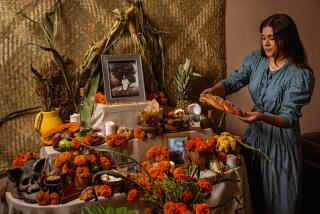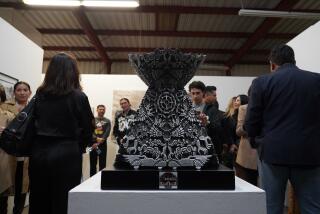Mexico City’s Window on a Bloody Aztec Past
- Share via
MEXICO CITY — The huge terra cotta-colored stone disk carved with the dismembered likeness of the goddess Coyolxauhqui seems to float in a polished field of coal-black basalt.
The contorted figure of the Aztec lunar deity is adorned with a headdress, serpent heads and belts, one of which fastens a human skull to her waist. Stylized scalloped edges and protuberances of bone indicate where limbs and neck are severed from the torso.
This is how Coyolxauhqui appears--two floors below--from the large third-story viewing well built inside the Great Temple Museum in downtown Mexico City. The museum, opened to the public Oct. 12, overlooks the excavation site--in the far southeastern corner of Mexico City’s Zocalo Plaza--of the Aztec Great Temple.
Viewing ease, however, wasn’t the only reason Mexican architect Pedro Ramirez Vasquez designed an overhead perch from which to observe the slightly oblong bas relief, which measures about 11 feet in diameter.
The monolith, which was accidentally discovered at the foot of the Great Temple by workmen in February, 1978, is meant to be seen as it was nearly half a millennium ago by Aztec warriors, priests and victims about to be sacrificed at the temple’s summit.
The institution of human sacrifice was widespread throughout Mesoamerica--an area which today extends from Central America to central Mexico--during pre-Columbian times. But David Carrasco and other scholars studying the temple excavation argue that the Aztec myth of Coyolxauhqui provided the justification for the geometric increase in human sacrifice which distinguished the Aztecs from their neighbors.
In the ancient myth, Coyolxauhqui learns that her mother has been magically impregnated by a tuft of feathers that falls from the sky. Enraged, she orders 400 warrior gods to climb Coatepec, or Serpent Hill, and kill her mother to avenge the dishonor. Huitzilopochtli, Coyolxauhqui’s unborn brother and Aztec patron god of war, learns of the attack and emerges from the womb in time for battle.
He decapitates Coyolxauhqui when she reaches Coatepec’s summit and kicks her corpse down the hill, causing her limbs to be severed before she comes to rest at the bottom. He then proceeds to kill and pursue the army of warrior gods.
The Great Temple, Carrasco said, was built as a model of Coatepec--a place where the Aztec military formula of exacting tribute from neighboring city states could be mythically consecrated.
A Glimpse of the Myth
Relative newcomers to the ancient urban civilizations of Central Mexico, the Aztecs sent out armies which terrorized their neighbors. From vanquished city states they demanded captives for sacrifice, massive amounts of precious stones and metals, cotton cloth and cacao beans--the pre-Columbian equivalent of money. At its peak, the Aztec empire embraced much of central, eastern and southwestern Mexico and parts of Central America.
Spanish chronicler Bernal Diaz del Castillo provided a glimpse of how the Coyolxauhqui myth may have been played out when he recounted the capture of Spanish soldiers by the Aztecs in 1520:
“...we all looked toward the lofty Pyramid...and saw that our comrades whom they had captured...were being carried by force up the steps and they were taking them to be sacrificed...and with things like fans in their hands they forced them to dance...and after they had danced they immediately placed them on their backs on some rather narrow stones which had been prepared as places for sacrifice, and with some knives they sawed open their chests and drew out their palpitating hearts and offered them to the idols that were there, and they kicked the bodies down the steps....”
Beyond its bloody legacy, Edwardo Matos Moctezuma, who headed the five-year excavation of the temple, said it has provided a rare opportunity to compare the written accounts of Spanish and Indian chroniclers with the archeological clues provided by the excavation.
In its glory, the temple--built in 13 successive stages after the founding of the Aztec capital, Tenochtitlan, in 1325--rose as high as 15 stories above a ceremonial compound containing 87 buildings and a city populated by as many as 200,000 residents--larger than any European city of the time. Its uppermost level supported two red shrines: one dedicated to Tlaloc, an ancient pre-Columbian rain deity; the other, to Huitzilopochtli. It’s no wonder that the Spaniards who first entered the Aztec capital were awestruck.
Equally fascinating have been the artifacts exhumed from within the pyramid itself.
From 1978 to 1982, some 7,000 ritual objects were excavated from the temple, startling the public and scholars alike. As Carrasco writes in his recently released book, “The Great Temple of Tenochtitlan,” “most of these treasures were obtained from offertory caches where effigies of deities, ritual masks, sacrificial knives, jade beads, human sacrifices, and minor sculptures were deposited with an enormous amount of real animal species.”
Decorated Human Skulls
From the more than 100 stone offertory boxes also emerged decorated human skulls, a pair of life-sized ceramic eagle warriors and huge sculpted stone conch shells, swordfish bills, shark teeth, pumas and relics from the ancient civilizations which preceded the Aztecs by hundreds of years.
Scholars discovered that placement of the objects was not haphazard. They were arranged in a premeditated fashion, or what Matos and his colleagues have interpreted as a highly stylized and abstract language. In one offering, for example, hundreds of seashells were placed in a north-south alignment. Above them, in a second layer, was a pair of crocodiles. The final layer was occupied by a seated figure of Xiuhtecutli, the ancient fire god.
Such an arrangement may represent a miniaturized version of what Matos and Carrasco call Aztec cosmovision--a hierarchical model of the universe in which seashells represented a vast cosmic sea, crocodiles the terrestrial plane and, in the heavens, Xiuhtecutli.
The offerings also provide an intimate view of how the Aztecs communicated to their gods with objects which still speak, Carrasco added, with an “enormous gorgeousness of power.”
Scientists found that the area around the outside of the temple echoed the structure’s internal duality: Scattered around the temple’s north or right side were offerings dedicated to Tlaloc; exhumed from its south side were items dedicated to the war god Huitzilopochtli.
Dual Principles Deified
Carrasco and his colleagues contend that the temple deified the dual principles which sustained the wealth and power of Aztec Tenochtitlan: tribute from Huitzilopochtli-inspired conquest and the agricultural and trade items associated with Tlaloc. (The new museum replicates the temple’s dual structure, with half of each of its four floors dedicated to Huitzilopochtli, the other half to Tlaloc.)
The temple’s design, Carrasco concludes, expressed the Aztec obsession to integrate the empire, in both time and space, within a symbolic center:
“It was the great meeting point of heaven, earth, and the underworld from which emanated supernatural authority for priests and rulers to organize the world,” he writes. “The place where tribute and monument were deposited and erected on a grandiose scale.”
More to Read
Sign up for Essential California
The most important California stories and recommendations in your inbox every morning.
You may occasionally receive promotional content from the Los Angeles Times.










